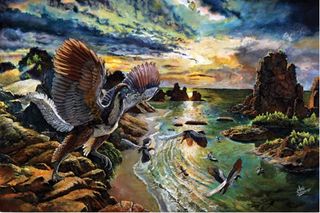'Phantom' Archaeopteryx, One of the World's 1st Birds, Could Probably Fly

After years spent sitting in private collections, a "phantom" fossil of one of the world's first known birds has finally seen the light of day. Now, scientists have determined that it's a previously unknown species within the famous genus of Archaeopteryx.
Archaeopteryx is a transitional fossil in the evolution of dinosaur to bird. Even so, it may come as a surprise to some people that this rare, crow-size creature could likely fly during its lifetime, the researchers said.
Like other early birds, this Archaeopteryx species had clawed fingers and sported tiny, sharp teeth, which "could grasp and slice prey, such as lizards, insects, snails and worms," said study lead researcher Martin Kundrát, a paleobiologist at Pavol Jozef Šafárik University in the Slovak Republic. [Avian Ancestors: Dinosaurs That Learned to Fly]
"I would describe it as a chicken with teeth and a long, bony tail," Kundrát told Live Science in an email.
Scientists named the newfound species Archaeopteryx albersdoerferi. The species name honors Raimund Albersdörfer, who owns the specimen and made it available to scientists, according to the study.
The first known Archaeopteryx was discovered in Bavaria, in southern Germany, in 1861. Since then, scientists have studied merely 12 skeletons of the 150-million-year-old creature, some of them fragmentary. (It's debatable how many species are in Archaeopteryx, but there are at least three: A. lithographica, A. siemensii and the newly named A. albersdoerferi.)
A few features set the newly analyzed specimen apart from previously studied specimens. For starters, the newly named Archaeopteryx is about 400,000 years younger than the other known "first birds," making it the youngest Archaeopteryx on record, Kundrát said. A. albersdoerferi is also the second smallest Archaeopteryx specimen on record, based on the length of the creature's ulna (a wing bone), he said.
Sign up for the Live Science daily newsletter now
Get the world’s most fascinating discoveries delivered straight to your inbox.
The fossil (one of the 12 skeletons found to date) was discovered in 1990 in the Mörnsheim Formation of Bavaria. "It changed hands several times before being sold cheaply to a private collector in the belief that it was a pterosaur," Kundrát said. "The scientific community was unaware of this specimen until 1996, when a cast of the specimen was shown briefly at the Naturkundemuseum [Natural History Museum] in Bamberg, Germany."
The original specimen became famous among scientists but was rarely seen, earning it the nickname "phantom." Finally, in 2009, Albersdörfer purchased the fossil from a private collector and offered it on long-term loan to the Bavarian State Collection of Paleontology and Geology in Munich. Albersdörfer also signed a contract saying that he would not sell the specimen to a nonpublic entity, ensuring that the fossil would be available to science, Kundrát said.
Fantastic flyer
To study the specimen, the scientists used synchrotron microtomography, a state-of-the-art, 3D X-ray-imaging technique. This allowed them to virtually reconstruct and dissect the A. albersdoerferi fossil, as well as identify skeletal adaptations in the animal that would have helped it fly.
It seems that A. albersdoerferi was, in fact, a better flyer than the other Archaeopteryx specimens, the researchers said. For instance, the newly named creature had thin, air-filled bones; a larger area of attachment of flight muscles on its wishbone; and a reinforced configuration of bones in its wrist and hand. It also had fused bones in its skull and fewer teeth than the older specimens, Kundrát said.
The virtual examination also revealed that A. albersdoerferi likely developed flight-related features as a juvenile, but more testing is needed to say so for sure, Kundrát said.
A family tree analysis also "convincingly vindicated the traditional placement of Archaeopteryx at the beginning (base) of the evolutionary tree of birds," Kundrát said. [Photos: This Dinosaur's Feathers Shimmered with Iridescence]
The research is a good step forward in the study of Archaeopteryx, said Steve Brusatte, a paleontologist at the University of Edinburgh in the United Kingdom, who wasn't involved with the research.
"What's so important about this new fossil is that it has been studied in detail using synchrotron tomography, which provides unprecedented detail on small features of the anatomy that are too difficult to see with the naked eye," Brusatte told Live Science. "It's clear that this new specimen has a lot of anatomical features indicative of a flying animal, like the highly vascularized shoulder and wing and the highly fused and reinforced hand."
Although scientists have debated Archaeopteryx's flying abilities for years, "when I look at this new fossil, I see the hallmarks of an animal that could flap its wings and keep itself airborne," Brusatte said.
The study was published online today (Oct. 25) in the journal Historical Biology. The research is dedicated to study co-researcher Junchang Lü, a professor at the Institute of Geology, Chinese Academy of Geological Sciences who unexpectedly died on Oct. 8 at the age of 53.
Originally published on Live Science.

Laura is the archaeology and Life's Little Mysteries editor at Live Science. She also reports on general science, including paleontology. Her work has appeared in The New York Times, Scholastic, Popular Science and Spectrum, a site on autism research. She has won multiple awards from the Society of Professional Journalists and the Washington Newspaper Publishers Association for her reporting at a weekly newspaper near Seattle. Laura holds a bachelor's degree in English literature and psychology from Washington University in St. Louis and a master's degree in science writing from NYU.
